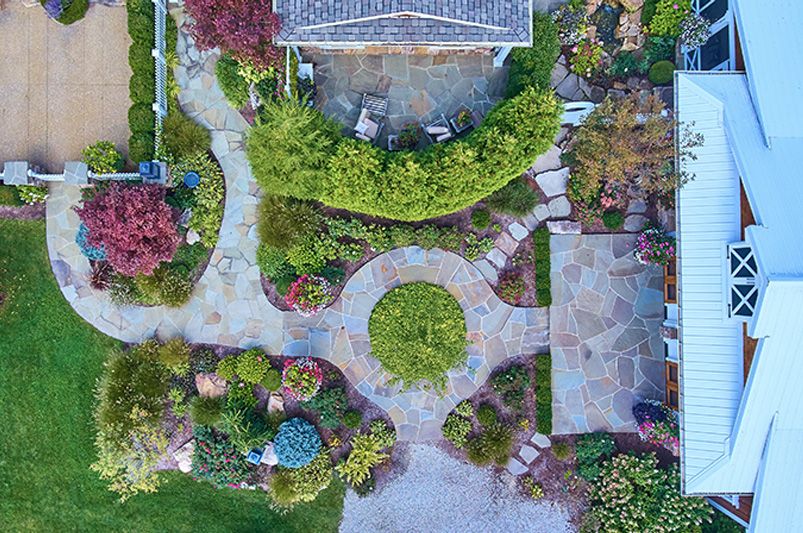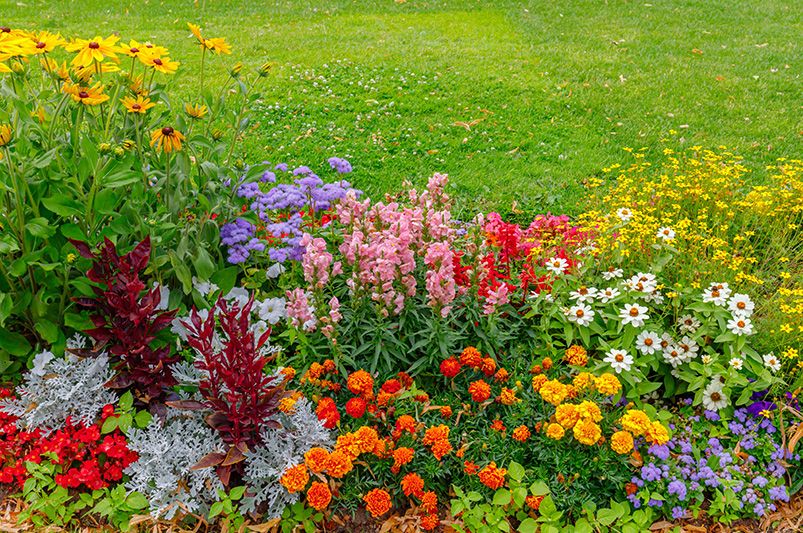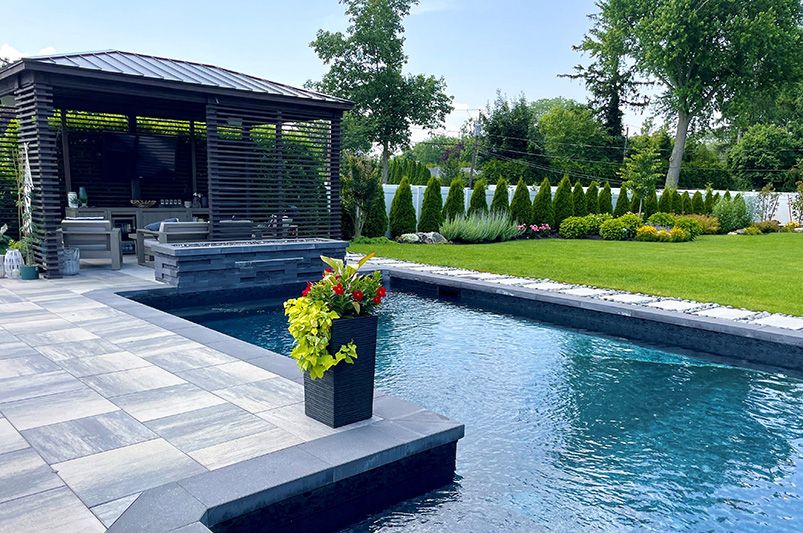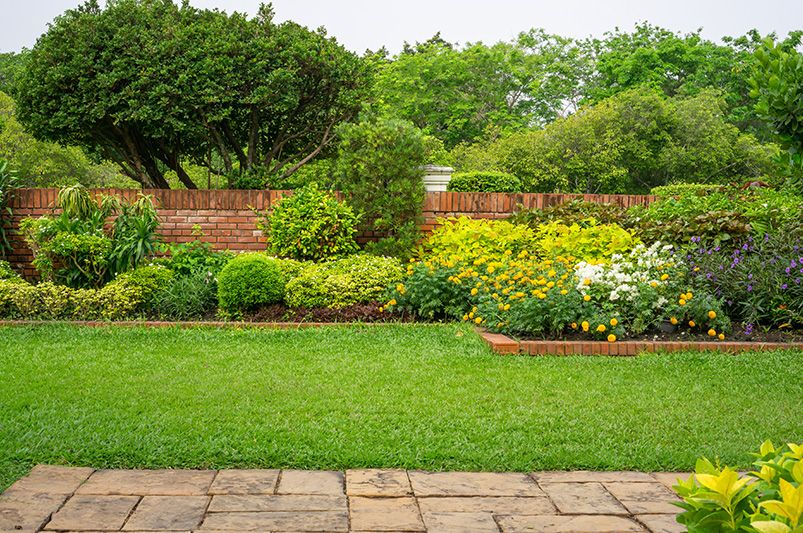
The Difference Between Softscape and Hardscape
Published: 30/08/2024 | Updated: 30/08/2024
The Difference Between Softscape and Hardscape
What is Softscape?
Softscape refers to the living, horticultural elements of a landscape. These components bring life, color, and texture to your garden, creating a dynamic and ever-changing environment. Understanding softscape elements and their benefits can help you make the most of your outdoor space.
Definition of Softscape
Softscape includes all the living components of a landscape, such as plants, flowers, trees, shrubs, and ground covers. These elements are typically more flexible and adaptable than hardscape features, allowing for seasonal changes and growth.

Common Elements of Softscape
- Plants and Flowers: Annuals, perennials, bulbs, and flowering plants add color, fragrance, and visual interest to your garden. They can be used to create focal points, borders, and layers of texture.
- Trees and Shrubs: These provide structure, shade, and privacy. They can also serve as windbreaks and habitat for wildlife.
- Ground Covers: Ground covers like grass, moss, and low-growing plants help to prevent soil erosion, suppress weeds, and create a lush, green carpet.
- Soil and Mulch: The foundation of any softscape, soil and mulch provide essential nutrients, retain moisture, and support plant health.
Benefits of Incorporating Softscape in Landscaping
- Aesthetic Appeal: Softscape elements add natural beauty and create a tranquil, inviting atmosphere. The variety of colors, textures, and shapes can enhance the visual interest of your garden.
- Environmental Benefits: Plants improve air quality by absorbing carbon dioxide and releasing oxygen. They also help to reduce soil erosion and provide habitats for birds, insects, and other wildlife.
- Flexibility and Adaptability: Softscape allows for seasonal changes and personal expression. You can experiment with different plant combinations, colors, and arrangements to create a unique garden that reflects your style.
- Temperature Regulation: Plants and trees help to cool the environment by providing shade and releasing moisture through transpiration, creating a more comfortable outdoor space.
Incorporating softscape into your garden design not only enhances its beauty but also supports a healthy and sustainable environment.

What is Hardscape?
Hardscape refers to the non-living, structural elements of a landscape. These components provide definition, functionality, and organization to your garden, creating a foundation that complements and enhances the softscape elements. Understanding hardscape and its benefits is essential for a balanced landscape design.
Definition of Hardscape
Hardscape includes all the man-made, solid features in a landscape, such as paths, patios, decks, walls, fences, and water features. These elements are typically more permanent and less adaptable than softscape features, providing stability and structure to your outdoor space.
Common Elements of Hardscape
- Paths and Walkways: These guide visitors through the garden, creating a sense of flow and connectivity. Materials like gravel, stone, brick, or concrete can be used to create durable and visually appealing paths.
- Patios and Decks: These areas provide outdoor living spaces for relaxation, dining, and entertaining. Patios are usually made of stone, concrete, or pavers, while decks are typically constructed from wood or composite materials.
- Walls and Fences: These structures define boundaries, provide privacy, and create focal points. Retaining walls can also help to manage soil erosion and create terraced garden areas.
- Water Features: Elements like fountains, ponds, and waterfalls add a soothing and dynamic element to the garden. Water features can attract wildlife and enhance the sensory experience of the outdoor space.
- Outdoor Structures: Gazebos, pergolas, arbors, and trellises provide shade, support climbing plants, and create architectural interest.
Benefits of Incorporating Hardscape in Landscaping
- Functionality and Usability: Hardscape elements create functional spaces for outdoor activities, making your garden more usable and enjoyable. Paths and patios provide areas for walking, sitting, and socializing.
- Structure and Definition: Hardscape elements give shape and form to your garden, creating clear lines and boundaries. This helps to organize the space and enhance the overall design.
- Low Maintenance: Unlike softscape elements, hardscape features require minimal maintenance. Once installed, they provide long-lasting structure and support with little upkeep.
- Weather Resistance: Hardscape elements are designed to withstand various weather conditions, providing stability and durability to your garden.
By incorporating hardscape into your garden design, you can create a balanced and functional outdoor space that complements the beauty of your softscape elements. In the next section, we will discuss the key differences between softscape and hardscape and how they can work together to create a harmonious landscape.

Key Differences Between Softscape and Hardscape
Understanding the key differences between softscape and hardscape is crucial for creating a balanced and aesthetically pleasing landscape design. While both elements are essential, they serve different purposes and offer unique benefits.
Visual Differences
- Texture: Softscape elements, such as plants and flowers, provide a variety of textures, from the delicate petals of flowers to the rough bark of trees. Hardscape elements, like stone paths and wooden decks, offer contrasting textures that add depth and interest to the landscape.
- Color: Softscape elements bring vibrant colors that change with the seasons, adding dynamic beauty to the garden. Hardscape elements typically have more neutral tones, such as the earthy hues of stone or the natural shades of wood, which provide a stable backdrop for the colorful softscape.
- Material: Softscape is composed of organic, living materials that grow and change over time. In contrast, hardscape consists of inorganic, permanent materials like stone, brick, and metal, which provide enduring structure and form.
Functional Differences
- Usage: Softscape elements create a natural, inviting environment that supports biodiversity and ecological health. Hardscape elements provide functional spaces for human activities, such as walking, dining, and entertaining, making the garden more usable and enjoyable.
- Maintenance: Softscape requires ongoing care, including watering, pruning, and fertilizing, to keep plants healthy and vibrant. Hardscape, on the other hand, is generally low-maintenance, requiring only occasional cleaning and minor repairs to maintain its appearance and functionality.
- Longevity: Softscape elements are dynamic and change with the seasons, requiring periodic replacement or replanting. Hardscape elements are durable and long-lasting, providing a stable foundation that can withstand the elements and the test of time.

How Softscape and Hardscape Complement Each Other
- Balance: A well-designed landscape incorporates both softscape and hardscape elements to create a balanced and harmonious environment. The softness and color of plants complement the solid, stable presence of hardscape features, resulting in a cohesive and visually appealing design.
- Function and Aesthetics: Hardscape provides the necessary infrastructure for functional spaces, while softscape adds the beauty and natural elements that make the garden inviting and serene. Together, they create a space that is both practical and aesthetically pleasing.
- Seasonal Interest: Softscape elements offer seasonal interest with changing colors, flowers, and foliage, while hardscape provides a constant, unchanging structure. This combination ensures that the garden remains attractive and functional year-round.
By understanding and utilizing the key differences between softscape and hardscape, you can create a landscape design that is both beautiful and functional.
Planning Your Landscape Design
Creating a balanced and cohesive landscape design involves careful planning and the thoughtful integration of both softscape and hardscape elements. Here are some tips to help you plan your landscape design and ensure that both elements work harmoniously together.
Tips for Creating a Balanced Design
- Assess Your Space: Begin by evaluating the size, shape, and natural features of your garden. Consider factors such as sunlight, shade, soil type, and drainage, as these will influence your choice of plants and materials.
- Define Your Goals: Determine the primary functions of your garden. Do you want a space for relaxation, entertainment, gardening, or play? Your goals will help guide your design decisions and the balance between softscape and hardscape elements.
- Create a Focal Point: Designate a focal point to draw the eye and create visual interest. This could be a beautiful tree, a water feature, or a piece of garden art. Use hardscape elements to frame the focal point and softscape elements to enhance it with color and texture.
- Use a Variety of Textures and Colors: Combine different textures and colors to add depth and interest to your landscape. Mix soft, flowing plants with hard, structured materials. For example, pair the softness of ornamental grasses with the solidity of stone pavers.
- Plan for Maintenance: Consider the level of maintenance required for both softscape and hardscape elements. Choose plants that are suitable for your climate and soil conditions, and select hardscape materials that are durable and easy to maintain.
Examples of Successful Integration
- Garden Pathways: Use stone or gravel pathways to guide visitors through your garden. Line the paths with a mix of flowering plants and shrubs to soften the edges and create a seamless transition between hardscape and softscape.
- Patio Areas: Create a patio or deck for outdoor living and dining. Surround the area with planters filled with colorful flowers and greenery to create a cozy, inviting atmosphere.
- Water Features: Incorporate a fountain, pond, or waterfall into your design. Use rocks and stones to construct the feature and plant a variety of moisture-loving plants around it to blend the hardscape with the natural environment.
Common Mistakes to Avoid
- Overcrowding: Avoid overcrowding your garden with too many plants or hardscape features. This can create a cluttered and unbalanced look. Allow enough space for each element to shine and grow.
- Ignoring Scale and Proportion: Ensure that the size of your plants and hardscape elements is proportionate to the size of your garden. Oversized features can overwhelm a small space, while undersized elements can get lost in a large garden.
- Lack of Cohesion: Aim for a cohesive design by choosing complementary materials, colors, and styles. A well-integrated landscape will have a unified look and feel, with each element enhancing the overall design.
By following these tips and avoiding common mistakes, you can create a stunning landscape that beautifully integrates both softscape and hardscape elements. This balanced approach will result in a functional, visually appealing, and enjoyable outdoor space.
For more personalized advice and design inspiration, explore ShrubHub’s landscaping services. Whether you need custom 3D landscape designs, high-quality plants, or expert recommendations, ShrubHub has you covered. Visit shrubhub.com to start planning your dream garden today.
Conclusion
Understanding the difference between softscape and hardscape is essential for creating a balanced and beautiful landscape. Softscape elements, such as plants, flowers, and trees, add life, color, and texture to your garden. In contrast, hardscape elements, like paths, patios, and walls, provide structure, functionality, and stability. By thoughtfully integrating both elements, you can design an outdoor space that is visually appealing, functional, and enjoyable year-round.
A well-balanced landscape not only enhances the aesthetic appeal of your home but also supports environmental health and biodiversity. Whether you aim to create a serene garden retreat, a lively entertainment area, or a functional outdoor living space, the harmonious blend of softscape and hardscape elements is key.
At ShrubHub, we are dedicated to helping you achieve your landscaping goals. Our comprehensive services include custom 3D landscape designs, a wide variety of high-quality plants and materials, and expert advice tailored to your needs. Let us help you bring your vision to life with our innovative and personalized solutions.




